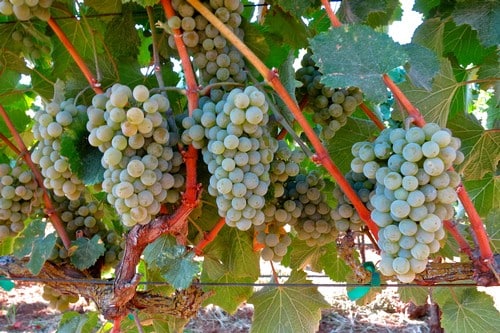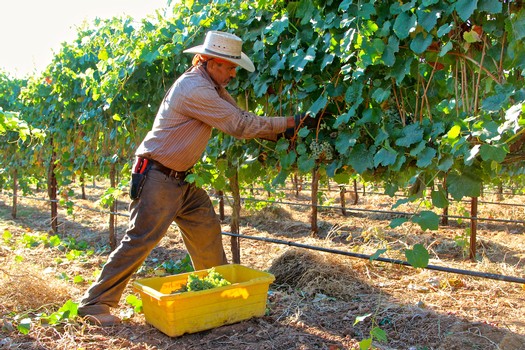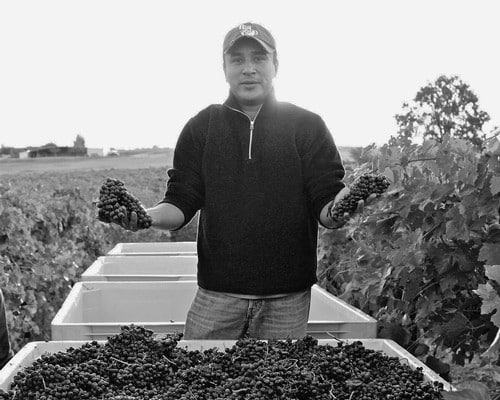MONDAY, APRIL 29, 2024. BY RANDY CAPAROSO.
Featured Image: Silvaspoons Vineyards owner/grower Ron Silva with his Alvarinho, a Portuguese clonal variant of Albariño.
Why Albariño is such a natural in Lodi
Albariño—a grape variety native to Spain’s Rías Baixas region, also grown in the neighboring Vinho Verde region of Portugal—is by no means the most important white wine cultivar in California. Not when there is over 126 times more Chardonnay cultivated in the state.
Yet among the wineries based in California’s Lodi appellation, Albariño has emerged as one of the most important of white wine varieties. There are more producers of Albariño in Lodi than there are brands of Chardonnay, Sauvignon Blanc, or Pinot Grigio (a.k.a., Pinot Gris).
Lodi, in fact, grows and produces more than a third of all the Albariño in California (see the USDA’s most recent statistics below). So just in this sense, this varietal has become the appellation’s signature white wine.
Why? Simply because Albariño grows so darned easily in Lodi’s warm, dry Mediterranean climate, despite the fact that Rías Baixas and Vinho Verde are located alongside the Atlantic Ocean rather than the Mediterranean Sea.
By “easily,” we mean in terms of both quantity and quality. Albariño is a generous producer. According to Bokisch Vineyards‘ Markus Bokisch, who was the first vintner to plant the grape in Lodi in 1995 (from cuttings brought in directly from Spain), Albariño yields an average of 7 tons per acre in the Lodi appellation—as much as 9 tons in the richer peat soils found in the Delta regions at the far western edge of Lodi, and closer to 5 tons in the more meager, shallower, low foothills soils to the east, in Clements Hills or Borden Ranch.
Typically smaller cluster morphology of Albariño grown in Lodi’s Clements Hills AVA.
Quality-wise, Lodi Albariño has proven to be a consistent “what’s-not-to-like?” grape: Yielding light to medium-bodied dry white wines with refreshing natural acidity, and virtually the entire fruit spectrum that has made Albariños from Spain an international sensation—including…
• Citrus (from orange to lemon)
• Stone fruit (from apricot to peach)
• Crisp fruit (apples and pear)
• Tropical fruit (pineapple or guava)
• Flowers (from “wild” to tropical)
• Occasional minerality (especially in lower alcohol/higher acid bottlings) or sea-like brininess.
Growers love it, winemakers love it, and most important of all, consumers love it. What’s-not-to-like, indeed?
The latest entry from Lodi’s Delta sub-region
Because it is so good and, better yet, distinctive among all other Lodi Albariños, it is worth singling out the latest producer of the varietal.
Despite the fact that Acquiesce Winery continues to win every award and “Best of Class” there is to win for their “white Rhône” varietals and blends—most recently, “Best in California” awards for their 2022 Bourboulenc and 2023 Grenache Rosé at last week’s 2024 California State Fair—for some reason this acclaimed producer has decided to come out with an Albariño as well.
A big reason, from what we understand, is because Lodi grape grower Ben Kolber, who operates KG Vineyard Management with his wife/partner Madelyn Ripken Kolber, asked them to (evidently, in Lodi, a polite request is reason enough to do anything). But because it is not a French Rhône varietal fitting into the brand’s signature portfolio, the wine is bottled under a “Christina’s Outlier” label, in reference to Acquiesce’s uber-talented winemaker/vineyard manager Christina Lopez.
Acquiesce Winery winemaker/vineyard manager Christina Lopez.
The 2023 Christina’s Outlier Lodi Albariño ($36.50) is, in a word, dazzling. As such, worth every penny. It is bone dry and light as a feather like almost all other Lodi Albariños. Where it differs, in dramatic fashion, from other Lodi Albariños is in its violet-like flowery nose (the floral quality of most Lodi Albariños is more tropical or wildflower-like), underscored by citrus and a lavender-pitched herbiness, plus a remarkably zesty, lemon flesh quality lifting the citrus/floral profile on the palate.
Having nursed the wine from beginning (whole cluster pressing, 48-hour cold soak) to end (100% stainless steel fermentation, tank aging on the lees, i.e., dead yeast cells), Lopez has always found a core of “pineapple guava from grandpa’s trees” in the wine, reminiscent of her childhood visits to Hawaii.
Above all—apart from being just plain energizing and nice—is the fact that Christina’s Outlier represents a distinctly Delta style of the varietal. It is the rich, fluffy peat soil of the Kolber family’s ranch that imposes an extensive leaf canopy and high enough yield that lead to the sharper, elevated acidity and ringing floral qualities in the nose, distinguishing it from other Lodi Albariños, and most certainly from Spanish or Portuguese imports.
Kolber family vineyards growing in the rich peat soils of the Delta area at the far western edge of the Lodi AVA.
Pervasive Lodi Albariño styles
As a group, Lodi-grown Albariños tend to be crisp, medium-bodied (i.e., neither light nor heavy), and multifaceted in the nose. The variations thereof are usually related to terroir: Primarily because most of Lodi’s Albariños are grown in the extremely deep (up to 100 feet) sandy loam soils surrounding the City of Lodi, they tend to capture most of the fruit, floral, and mineral facets of the varietal.
For the most part, choices of oak barrels do not play a part in winemaker styles in Lodi; mainly because stainless steel fermentation, sans barrel fermentation or aging, is the predominant methodology followed by Lodi vintners (why blur subtle fruit profiles with strong oak qualities?). With, of course, a few exceptions.
Farming and picking decisions—having direct impacts on, say, levels of alcohol and perception of acidity—seem to factor in almost as much as individual sites when it comes to differentiating sensory qualities found in Lodi Albariños.
This comparison of typical Lodi Albariño cluster morphology demonstrates the direct impact of terroir on the grape, manifested in bottlings: (from left) from the Mokelumne River, Clements Hills (middle), and the California Delta (right).
A run-down on some of the leading brands, sub-appellations and bottlings:
Harney Lane Winery, Home Ranch, Mokelumne River-Lodi Albariño
Since its first vintage in 2007, Harney Lane Winery has refined its approach to the varietal to the point where it has become among the most precisely balanced and nuanced in the appellation. The nose is typically very “Lodi”—reflecting the sandy loam soil of Mokelumne River-Lodi—in its honeyed, tropical fragrances mingling with citrusy notes and suggestions of Asian pear.
On the palate, a Harney Lane estate-grown Albariño is very fine and silky in texture; its tropical and citrus fruit sensations are lifted by zesty, edgy acidity and tucked into a svelte medium body (typically just around 13% ABV). While most of this wine sees strictly stainless steel tanks, a tiny portion is aged in neutral French oak to round out the edginess of the natural grape acidity, giving the wine a light, deft, cannily balanced feel.
Klinker Brick Winery winemaker Joseph Smith.
Klinker Brick Winery, Mokelumne River-Lodi Albariño
Grown on one of the more beach-like sandy patches of Lodi’s Mokelumne River AVA (right behind the Klinker Brick Winery tasting room), this estate-grown bottling yields a fresh peach, citrus, and tropical flower-scented style of Albariño which practically leap from the wine glass.
An occasional lavender-like herby note in the nose is indicative of the winery’s preferred picking level when grape sugars are low and acidity on the high side; rendering palate feels that are precise and snappy with lemon-like crispness, packaged in a light-medium body (alcohol levels closer to 12% than 13%), simultaneously caressing and perking up the palate.
Albariño clusters growing in Mettler Family Vineyards’ loamy sand, on the east side of Lodi’s Mokelumne River AVA.
Mettler Family Vineyards, Mokelumne River-Lodi Albariño
Mettler Family Vineyards‘ Albariño block yields another wine grown on the loamy sand of the east side of the Mokelumne River, rendering a multifaceted nose combining tropical flowers with cut lemon and orange blossom fragrances. Airy light, almost to the point of being delicate, this wine gives an easy-going feel emphatically punctuated by lightly tart, balancing acidity. Typical of Lodi Albariños in its effortless sense of levity and varietal precision, enhanced all the more by mouth-watering acidity and restrained winemaker intervention.
Bokisch Vineyards, Las Cerezas Vineyard, Mokelumne River-Lodi Albariño
Coming from the Bokisch family’s “mother block” (original planting of selections brought in from Spain in the mid-’90s) tucked into a super-sandy oxbow bend of the Mokelumne River, this bottling has recently been something of an “outlier” itself, mostly because recent vintages have seen a small proportion of barrel fermentation and aging, whereas Lodi Albarińos almost as a rule have been 100% stainless steel fermented and bottled, seeing zero barrel influence.
Viticulturally the Las Cerezas Vineyard is also unusual in its close-spaced, trellised “small vine” farming, which produces lavishly aromatic expressions of the varietal profile; its generously floral and orange peel-like fragrances attenuated by a mild creaminess resulting from partial barrel fermentation. Despite the oak influence, the finish of Las Cerezas is typically light, nimble, and entirely refreshing.
Close spacing, small vine trellised Albariño in Bokisch Vineyards’ Las Cerezas Vineyard, tucked along a Mokelumne River Riverbend.
Lewis Grace Winery, Silvaspoons Vineyards, Alta Mesa-Lodi Alvarinho (bottled as Albariño)
Although it is not a local winery, it is worth remarking that the Placerville-based Lewis Grace Winery has been bottling an Albariño that is singularly unique because: 1) it is actually made from a Portuguese clone of the grape called Alvarinho; 2) it is grown by Silvaspoons Vineyards in Lodi’s Alta Mesa AVA, a sub-appellation distinguished by a shallow, gravelly/sandy clay soil in the San Joaquin series (which also happens to be California’s state soil because it is predominant in Sacramento County).
Back in 2014, Lodi’s Oak Farm Vineyards bottled an Albariño sourced entirely from Silvaspoons that ended up winning the Best of Show among all California white wines entered into the 2015 California State Fair. This was an impressive feat, but never again duplicated because Oak Farm Vineyards now produces Albariño entirely from its own estate vineyard, at the north end of Lodi’s Mokelumne River AVA. Oak Farm’s own Mokelumne River Albariño is typical of the sub-appellation—albeit a more delicate, fruit-driven rendering of the flowery/citrusy Lodi style.
Lewis Grace’s bottlings of Albariño, sourced entirely from Silvaspoons’ Alvarinho block, have consistently produced dry whites with an even more pronounced flowery variation of the varietal scent. Although less lavender-like than that of the Kolber family’s Delta-grown Albariño, the profile is always ultra-bright, super-citrusy, and palate-slaking—like lemon and lime mixed with drippy nectarine. The fresh qualities in the nose pop up on the palate, yet come across as light, airy, crisp, and refreshing, finishing with satin-smooth texturing.
For those who wish to explore this clonal variant of Albariño further: Other producers of wines made from Sivaspoons Vineyards Alvarinho include Omega Road Winery, Field Theory®, and Parea Wines.
Albariño harvest in Bokisch Vineyards’ Terra Alta Vineyard in Lodi’s Clements Hills AVA.
Bokisch Vineyards, Terra Alta Vineyard, Clements Hills-Lodi Albariño
The second and most productive of the Bokisch family’s vineyard sources are grown on a leaner, shallower, gravelly clay slope in Lodi’s Clements Hills appellation—a virtual opposite of the deep sandy soils of the Mokelumne River. This terroir yields Lodi’s tightest, leanest style of the varietal and is most definitely acid-driven—a direct reflection of the less expansive leaf canopies and smaller cluster/berry plant morphology resulting from this particular soil type and hillside topography.
Aromatically, you typically find an exceptionally fresh nose of crisp apples and fragrances of tart citrus blossoms and fruits in a Terra Alta bottling. This fruit profile is manifested in a lemony crisp, light, airy, and palate-freshening sense of dryness, with a pinpoint balancing acidity. The alcohol level, typically in the 12.5% range, gives a lithe, palate-freshening feel, lending a laser-sharp articulation to the varietal character, which is still flowery enough to scream “Lodi.”
Anaya Vineyards owner/winemaker Gerardo Espinosa in his family’s Clements Hills-Lodi vineyard.
Anaya Vineyards, Potrero Vineyards, Clements Hills-Lodi Albariño
Like Bokisch’s Terra Alta bottling, Anaya Vineyards‘ Albariño is grown in the reddish, shallow, gravelly, sloping clay soil of Lodi’s Clements Hills. Also like the Terra Alta, the predominant fruit profile is citrusy like lemon peel, veering towards orange wedges, with decidedly quieter suggestions of tropical flower or fruit, while retaining a heightened sense of acidity on the palate.
Where Anaya’s bottlings graphically differ from other Lodi Albariños is in how the wine is rendered in the winery: Through 100% neutral French oak barrel fermentation and aging (12 months), which lend a slightly denser, dryer feel to the palate, the creamy quality from the oak adding a transparent textural veneer to this particular variation of the varietal profile.
In short, an even meatier version of the grape, yet lively with the acidity typical of the grape (this is no Chardonnay wannabe!). Enjoy this the same way that you would squeeze lemon or oranges into a roast chicken, or squeeze citrus fruits over pork or veal. Heck, if you prefer a crisp white wine rather than a red wine with a grilled steak or cut of lamb (try deglazing with butter and white wine), this would be the perfect alternative.
2023 Albariño harvest in Clements Hills-Lodi.
Randy Caparoso is a full-time wine journalist who lives in Lodi, California. Randy puts bread (and wine) on the table as the Editor-at-Large and Bottom Line columnist for The SOMM Journal, and currently blogs and does social media for Lodi Winegrape Commission’s lodiwine.com. He also contributes editorials to The Tasting Panel magazine, crafts authentic wine country experiences for sommeliers and media, and is the author of the new book “Lodi! A definitive Guide and History of America’s Largest Winegrowing Region.”
Have something interesting to say? Consider writing a guest blog article!
To subscribe to the Coffee Shop Blog, send an email to stephanie@lodiwine.com with the subject “blog subscribe.”
To join the Lodi Growers email list, send an email to stephanie@lodiwine.com with the subject “grower email subscribe.”
To receive Lodi Grower news and event promotions by mail, send your contact information to stephanie@lodiwine.com or call 209.367.4727.
For more information on the wines of Lodi, visit the Lodi Winegrape Commission’s consumer website, lodiwine.com.
For more information on the LODI RULES Sustainable Winegrowing Program, visit lodigrowers.com/standards or lodirules.org.














